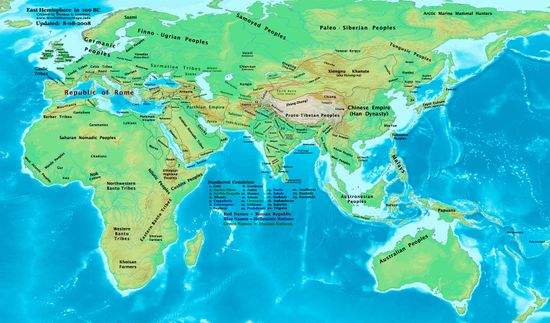قائمة الكيانات السياسية في القرن الثاني ق.م.
The development of states—large-scale, populous, politically centralized, and socially stratified polities/societies governed by powerful rulers—marks one of the major milestones in the evolution of human societies. Archaeologists often distinguish between primary (or pristine) states and secondary states. Primary states evolved independently through largely internal developmental processes rather than through the influence of any other pre-existing state. The earliest known primary states appeared في بلاد الرافدين حوالي 3700 ق.م., في مصر حوالي 3300 ق.م., في وادي السند حوالي 2500 ق.م.، الهند حوالي 1700 ق.م.، وفي الصين حوالي 1600 ق.م. As they interacted with their less developed neighbors through trade, warfare, migration, and more generalized ideological influences, the primary states directly or indirectly fostered the emergence of secondary states in surrounding areas, مثل، الحيثيون في الأناضول، الدول المينوية والموكنية في الحضارات الإيجية أو الممالك النوبية في السودان. According to Professor Gil Stein of the University of Chicago Oriental Institute, "The excavations and archaeological surveys of the last few decades have vastly increased both the quantity and quality of what we know about ancient states and urbanism. Archaeologists have broadened the scope of their research beyond the traditional focus on rulers and urban elites. Current research now aims at understanding the role of urban commoners, craft specialists, and village-based farmers in the overall organization of ancient states and societies. Given the immense geographical scope encompassed by the term 'the Ancient World'".[1] The notion of a sovereign state arises in the 16th century with the development of modern diplomacy. For earlier times, the term "sovereign state" is an anachronism. What corresponded to sovereign states in the medieval and ancient period were monarchs ruling by the grace of God, de facto feudal or imperial autocrats, or de facto independent nations or tribal confederations.
This is a list of sovereign states that existed between 200 ق.م. و 101 ق.م.
الدول ذات السيادة
| الدولة ذات السيادة | الأعوام |
|---|---|
| ثقافة أدِنا | 1000 - 200 ق.م. |
| ألبانيا | القرن الرابع ق.م. - القرن الثامن م. |
| Ardiaean Kingdom | ح.260–168 ق.م. |
| أرمنيا | 190 ق.م. - 428 AD |
| أتروپاتنى | ع320 ق.م. - القرن الثالث م. |
| بيثينيا | 297 - 74 ق.م. |
| بويو | القرن الثاني ق.م. - 494 م |
| الامبراطورية القرطاجية | 650 - 146 ق.م. |
| Chavín culture | 900 - 200 ق.م. |
| Chera Kingdom | 5th century ق.م. - AD 1102 |
| كوماگنه | 163 ق.م. - 72 م |
| المملكة الدردنية | ح.448 ق.م. – 28 ق.م. |
| دونگيى | القرن الثالث ق.م. - القرن الخامس م. |
| گوجوسون | 2333 - 108 ق.م. |
| المملكة اليونانية-الباكترية | 256 - 125 ق.م. |
| امبراطورية هان | 206 ق.م. - 220 م |
| أيبريا | 302 ق.م. - 580 م |
| المملكة الهندو-يونانية | 180 ق.م. - 10 م |
| المملكة الهندو-سكوذية | 200 ق.م. - 400 م |
| اليابان | 660 ق.م. - الحاضر |
| دولة جين | القرن الثالث ق.م. - القرن الثاني ق.م. |
| كوش | 1070 ق.م. - 350 م |
| ليكاونيا | القرن الثامن - 200 ق.م. |
| مقدونيا | القرن الثامن ق.م. - 146 ق.م. |
| مورطانيا | 110 ق.م. - 40 م |
| امبراطورية موريا | 321 - 185 ق.م. |
| حضارة المايا | |
| مينيوى | 224 - 110 ق.م. |
| المملكة النبطية | 168 ق.م. - 106 م |
| نوميديا | 202 - 46 ق.م. |
| أوكجيو | القرن الثاني ق.م. - القرن الخامس م |
| مملكة الرها | 132 ق.م. - 244 م |
| Paracas culture | 600 - 175 ق.م. |
| الامبراطورية الپارثية | 247 ق.م. - 224 AD |
| پنطس | 291 ق.م. - 62 AD |
| المملكة الپطلمية | 305 - 30 ق.م. |
| الجمهورية الرومانية | 509–27 ق.م. |
| Sātavāhana Empire | 230 ق.م. - 220 AD |
| سكوذيا | القرن الثامن ق.م. - القرن الثاني م. |
| الامبراطورية السلوقية | 312 - 63 ق.م. |
| اسبرطة | القرن 11 ق.م. - 195 ق.م. |
| Scordisci | ح.278 ق.م. - 50 ق.م. |
انظر أيضاً
- قائمة دول العصر البرونزي
- قائمة دول العصر الحديدي
- قائمة دول العصر الكلاسيكي
- قائمة الدول أثناء القدم المتأخر
- قائمة الدول أثناء العصور الوسطى
قائمة الكيانات السياسية في القرن الثاني ق.م.
| ||
| سبقه القرن الثالث ق.م. |
الدول ذات السيادة في القرن الثاني ق.م. |
تبعه القرن الأول ق.م. |
الهامش
- ^ Stein, Gil J (2001). Understanding Ancient State Societies in the Old World. New York: Kluwer Academic/Plenum Press. pp. 353–379.
